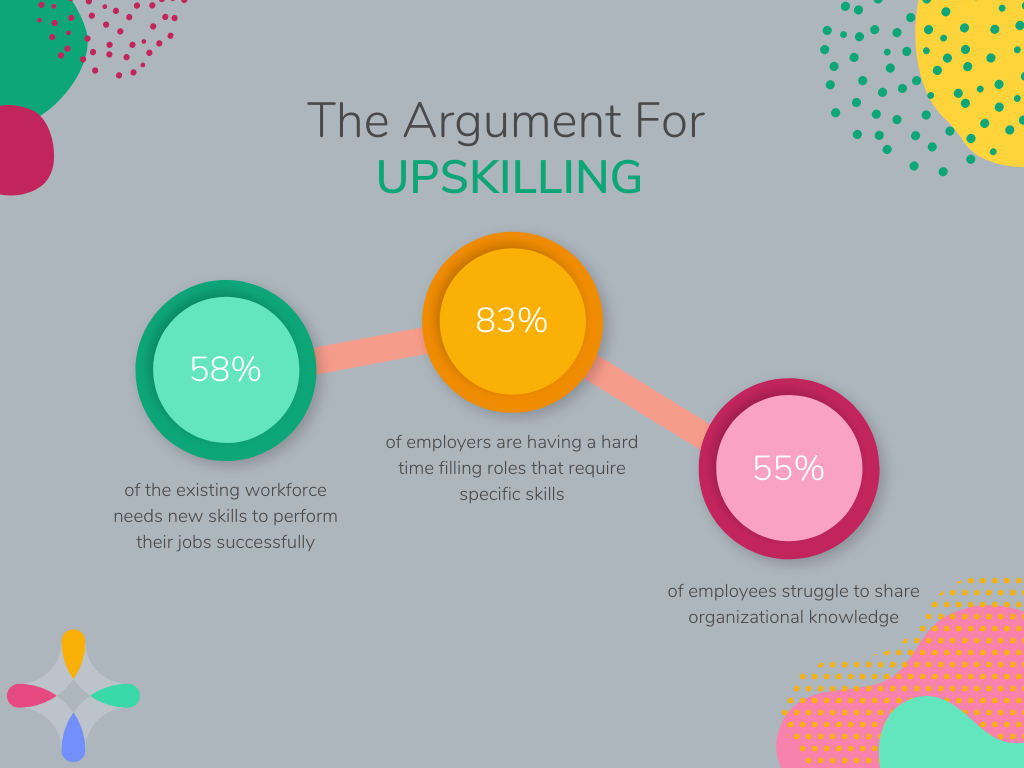Upskilling: What Does This Buzzword Mean?
Posted by Noel • January 7, 2022 • 6 min read
Upskilling is one of the most popular terms within the human resources space right now, and with good reason. It is a trend that promotes continuous learning and improvement of existing employees, rather than hiring new ones. It focuses on training, mentoring, and improving current employee skill sets so that they can either advance within the company (allowing for lower-level hires) or so that they can fill in the gaps within a department.
When we think about upskilling, there are a few different approaches companies will use, including:
- E-learning courses
- Mentoring or shadowing existing employees
- A combination of the two
Often, the tools used to upskill existing employees save thousands of dollars for companies. To learn about one of the best-rated learning management systems on the market today, click here to schedule a demo for Trakstar Learn.
Why Is Upskilling Important for HR Leaders?
Retaining employees is quickly becoming a primary focus for most human resource departments. It saves money, time, and creates a better culture. Working against that focus, however, is technology. Technology is changing rapidly and new tools are released on a weekly basis – companies need to adjust and pick up these new tools to stay competitive. This creates gaps within a company that need to be filled. Most companies cannot hire new people for every new tool, they need to train the employees they already have.
There is a bit of a give and take with upskilling: for their new skills, employees expect some kind of reward or advantage because of their new skills. In return, companies increase employee productivity and loyalty: two things hardest to come by for most businesses.
Building An Upskilling Plan
As part of your HR plan for the new year, you need to include upskilling as a primary focus. However, you cannot teach employees new skills without first identifying where the gaps are in your business. Even then, you still need to identify the best ways to fill those gaps. Sometimes, it may seem like common sense. Other times, you will need to dig deeper into the data. You need to see who is underperforming, who is overperforming, and who is a good fit for certain skills. HR leaders need to be able to explain to HR managers and employees why those skills are so important to learn or they will take a passive approach to the training.
Once you identify those skills, you must consider the impact on not only those employees, but on the business as a whole. HR leaders need to talk to C-suite executives to determine what goals are the most important within a given sprint.
Next, HR leaders need to build out the learning materials and training programs. The key is to build something that is as evergreen as possible, is measurable, and can be done remotely. Trakstar Learn is a good example of software that helps leaders build training modules that they can automatically send to employees, adjust to new trends, and monitor performance to report back to executives. For more information about Trakstar Learn, visit this page or schedule a demo today.
If you aren’t sure where to look for upskilling opportunities, you can use performance review season to ask questions about whether or not someone is happy within their current role or whether they’d like to learn something new. You can also talk to department managers and leaders who may have some insight. For more information on how to ask better questions during performance appraisals, download the whitepaper Modernize Your Performance Appraisals.
Upskilling Examples
Upskilling almost always includes using new tools, programs, and strategies within the workplace. However, there are more upskilling opportunities out there than you may expect. Upskilling doesn’t necessarily mean something that will directly impact the business. Sensitivity training, educational rebates, conferences, training, leadership development, and more all fall under the umbrella of upskilling. Other examples include:
- Certifications
- Software training
- Professional development
- Personal development
- Mentoring and shadowing opportunities
- Lunch-and-Learns
- Online courses
- Quizzes
- Reading
Upskilling techniques depend on the skill, the workplace, and the individual. Sometimes, it makes sense for a lunch-and-learn, and other times an online course is more practical. With learning management software, HR leaders have the power to personalize their courses so that employees learn the skills they need to do their jobs and succeed.
What Are The Benefits To Upskilling?
Why should HR leaders take their resources and use them to upskill? Upskilling helps existing employees, those who already have experience within your organization, become leaders. It improves their experience and can even create company loyalty. Upskilling, therefore, decreases hiring and onboarding costs that can eat away at your budget. Other benefits include better employee engagement – if you show that you are taking an interest and an investment in your employees, they are more likely to show an investment in the company itself.
Upskilling also leads to better productivity among employees. Employees who understand the tools they use will excel in their jobs and do the work more quickly than those who need to look up how to use tools.
Retention is the biggest benefit to upskilling: upskilling decreases employee turnover at all levels. Part of that is because employees feel like they are important to the company, and another part is that most people do enjoy learning new things and not all jobs offer that opportunity.
For more information about the benefits of upskilling, the Harvard Business Review found the following:
Reasons Upskilling Might Not Work For You
Have you tried upskilling before and it didn’t work for you? There are some ways that this practice can go wrong. You are more likely to see success with upskilling if you avoid the following:
Boring Training: Training can be boring, we all know that. In-person presentations, lecture-style learning, and reading materials can be ineffective to employees. Training materials need to be engaging, interesting, and convenient for them. Using a learning management system can help you to build effective learning materials and courses that provide feedback as soon as someone finishes the course. For more information about Trakstar Insights, click here.
You upskill once. For retention efforts, ongoing training and upskilling is important. Set aside time each week or month to develop new initiatives and reach out to the employees best suited for upskilling. There are many ways you can continue upskilling: it doesn’t have to simply be through courses. Sending out articles, infographics, or checklists can promote learning.
Need Help Upskilling Your Employees?
Upskilling requires the use of one of the best learning management systems on the market today. Not only do you need to be able to teach your employees, but you need to have the reports, data, and information handy to gain insights into who is doing training, how they are doing, and who still needs to complete a course. Trakstar Learn is a system that gives you all of that and more, complete with our renowned support, easy-to-follow implementation, and more. Click here to schedule a live demo.
Don't Miss Out on More Great HR Articles!
Subscribe to get the latest, greatest HR and Talent Development content straight to your inbox.



